The Birth of Traditional Chinese Clothing: A Journey Through Time

Hanfu refers to the traditional clothing worn by the Han people, with its origins dating back to the time of the legendary rulers Yao, Shun, and Yu. According to the Records of Historian, it is recorded that “Emperor Huang, Yao, and Shun wore long robes, and the world was governed in harmony” (黄帝、尧、舜垂衣裳而天下治). Over more than 5,000 years, the essence of Hanfu has remained unchanged. During the eras of Yao, Shun, Yu, and the Emperor of the Yan tribe, the basic form of Hanfu emerged. After the Zhou Dynasty established standardized norms for Hanfu, the clothing gradually became more refined and widespread during the Han Dynasty. It was during the prosperous reigns of Emperor Wu and Emperor Guangwu that Hanfu became increasingly influential, leading to the term “Hanfu” being coined.
I. The Choice of Colors in Hanfu
The development of Hanfu was deeply influenced by the philosophy of Yin-Yang and the Five Elements (Wu Xing). The Five Elements—Metal, Wood, Water, Fire, and Earth—were associated with five basic colors: green, red, black, white, and yellow, collectively referred to as the “primary colors” (正色), with yellow being considered the most prestigious.

Yellow was designated as the color of the emperor’s garments, symbolizing the unification of all regions under heaven. Furthermore, this system dictated that the emperor’s clothing colors should change according to the seasons: green for early spring, red for early summer, yellow for midsummer, white for early autumn, and black for early winter. The color combinations in Hanfu were magnificent and luxurious, while also exuding elegance and sophistication.
For the clothing of commoners, the people created colors that blended the primary colors based on the Yin-Yang theory of mutual generation and restriction. These colors, which can be referred to as “intermediate colors” (间色), formed the base colors of traditional attire, passed down through generations. The use of intermediate colors enriched the overall color palette of Hanfu and also played a role in distinguishing social and official ranks. These colors helped to reflect the differences in officials’ positions and the nature of their political duties.
II. The Connection Between Hanfu and the Social Hierarchy
Confucianism, the dominant philosophy in ancient China, greatly influenced societal norms, with principles such as “Preserve the way of heaven, eliminate human desires” (存天理,灭人欲) emphasizing moral codes for feudal society. The Chinese system of rites and etiquette established a hierarchical structure, where every class—from commoners to the emperor—had the right to wear different types of clothing according to their social rank.
In terms of garment design, there was an emphasis on restoring the revered ancient styles, with most clothing made from plain colors and simple, non-luxurious materials. The colors often reflected the natural hues of the fabric itself. The strict social hierarchy ensured that the system of rites protected the privileges of the royal and noble families, thus maintaining stability across the entire country.
III. General Principles of Hanfu Design
Firstly, in terms of design, although Chinese civilization spans over 5,000 years, each dynasty had its own unique styles and characteristics, there are several fundamental principles that remained consistent throughout:
1. The first type consists of a top garment paired with pants.
2. The second type is a robe where the upper and lower parts are connected as one piece.
Secondly, in terms of gender differences, women more commonly wore the first type of design, which lasted for a longer period. Men, on the other hand, were more likely to wear the second type of connected robe. Men would often adorn their heads with crowns, scarves, or hats, while women would style their hair in various ways, often decorating it with pearls, flowers, and other accessories like Bù yáo (it could roughly translates to “step-shake” because the ornament would move or “shake” as the wearer walked.)
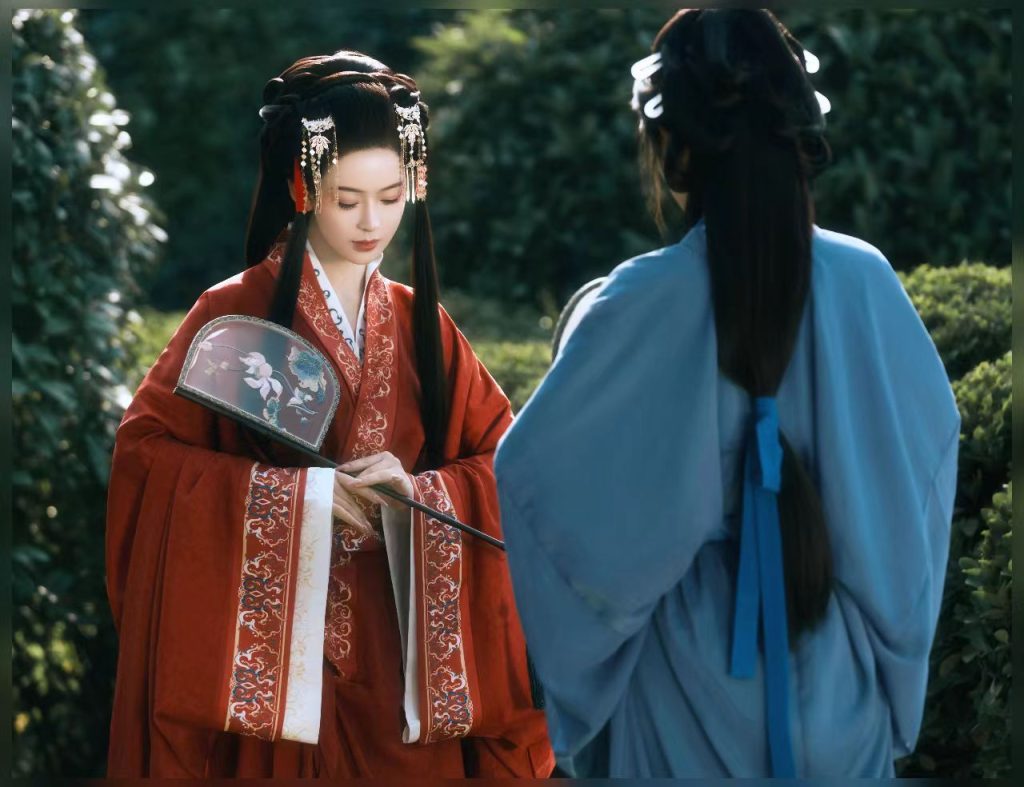
Thirdly, on the topic of patterns, Hanfu often features designs inspired by animals, plants, and geometric shapes. These patterns were primarily based on local wildlife and flora. A famous example of this can be seen in the “Shang Zhou” mamian skirt pattern by the Chinese Hanfu brand Weaving Division, which was inspired by the sun bird totem belief of the ancient people of the Shu region. The Shu area, in ancient times, was known for its frequent rain and rare sunrises. This lack of sunlight severely impacted China’s agrarian civilization. According to legend, the Sun God Bird was a mythical bird that could communicate with the sun, bringing the rare sunlight to the people. This reflects the long-held Chinese value of “harmonious coexistence” with both animals and plants, a belief that dates back to ancient times. Below is an image of a Sun God Bird gold ornament from the Shang-Zhou period.

Fourthly, in the culture of accessories, during the Spring and Autumn and Warring States periods, in addition to the aristocracy wearing luxurious clothing, their ministers also adorned themselves in extravagant fashions. They often wore jade and precious stones at their waists to showcase their unique taste and social status. For example, when it came to headgear, officials would decorate their hats with valuable materials such as gold, pearls, and jade, further enhancing their noble appearance and reinforcing their prestige.
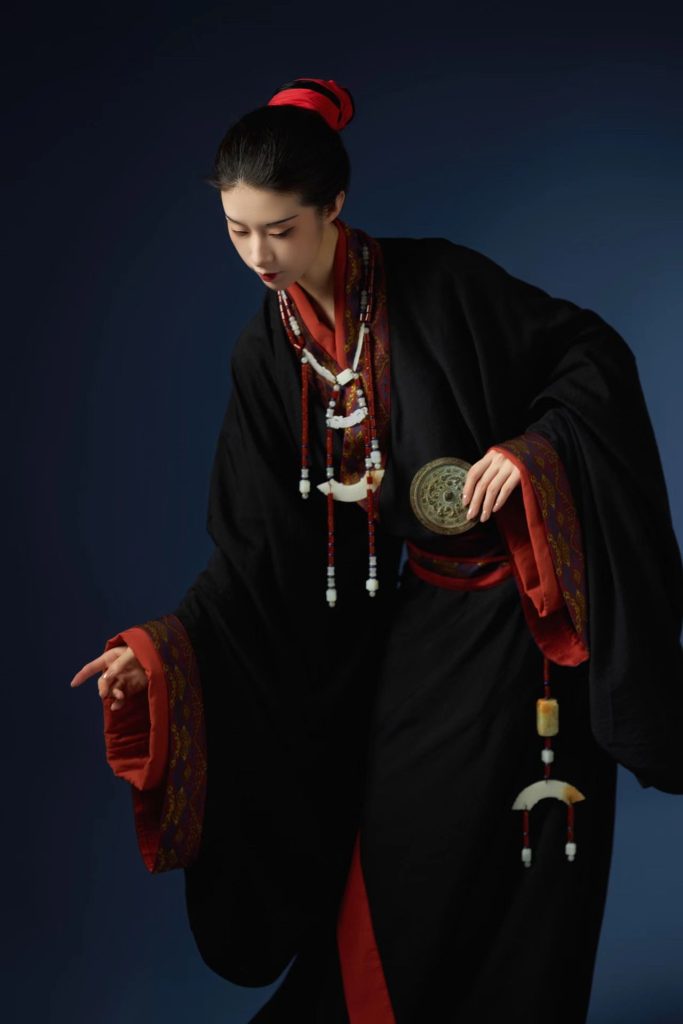
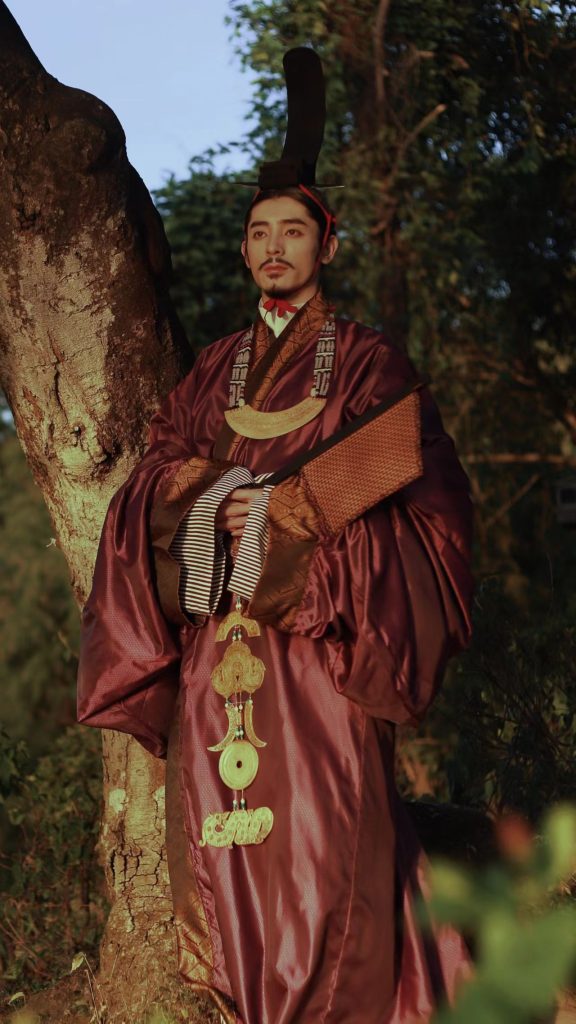
Finally, there is a clear class distinction in clothing. Generally, the upper class wore loose and comfortable styles, concealing most of their bodies, while the working people or those from the lower social strata wore tighter, more compact clothing. This was because snug clothing was more practical for agricultural labor and daily activities. The modern Hanfu that we are familiar with today actually evolved from the luxurious clothing of the aristocratic class.
V. The Cultural Connotation and Influence of Hanfu
We can say that Hanfu not only represents the clothing of the Han people, but its design also influenced the development of traditional clothing in other East Asian countries, such as Japan’s kimono, Korea’s hanbok, and Vietnam’s Việt Phục. These garments were all derived from Hanfu and modified over time. A significant contributing factor to this influence is the idea of “unity of heaven and man” (天人合一).
The Chinese believe that humans and all things in the universe are interconnected, with a harmonious and intimate relationship between people and the cosmos. In contrast, Western mainstream thought views relationships between things as either a process of transformation or a confrontation, where one either conquers the other or is conquered. Specifically, Hanfu embodies grandeur, fairness, integrity, and inclusivity.
For example, during the Han Dynasty, ancient women traditionally wore the shenyi, a garment where the top and bottom were connected. In earlier times, it was worn as undergarments, but by the Han period, it became formal attire for women. The wide sleeves of the shenyi symbolized the harmonious nature of the cosmos, while the right-angle collar represented the upright and proper order of the earth. The image below, Partial Image of a Silk Painting from the Tomb of Chenjia Dushan, Changsha, Hunan, shows an example of the style.

Today, the number of Hanfu enthusiasts is growing rapidly, with Hanfu societies in universities across China dedicated to showcasing Hanfu culture. At the same time, the market for Hanfu is expanding steadily. According to incomplete statistics, the Hanfu sales in Caoxian, China, alone reached 7.215 billion RMB in 2023. We believe that, through the test of time and innovative evolution, Hanfu will allow people from all around the world to deeply appreciate its beauty.
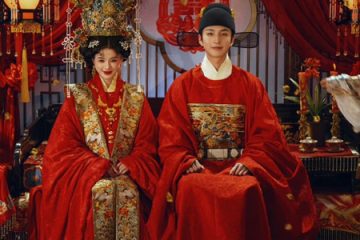
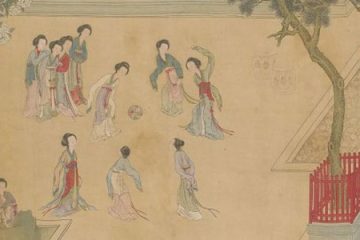
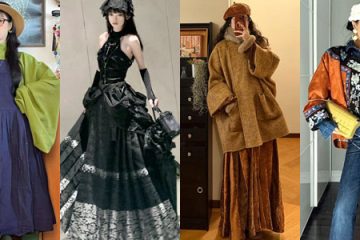
0 Comments